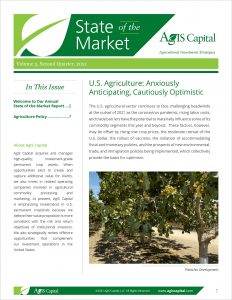Cody Dahl, Ph.D., Vice President, Acquisitions and Strategy, periodically produces AgIS Capital’s State of the Market newsletter to provide analysis on agricultural market dynamics for the benefit of the firm’s investors and friends.
We sat down with Cody to discuss his insights on some key themes and trends in the latest newsletter and their investment implications. Click here to read Volume 5 of the State of the Market analysis.
Cody Dahl, Ph.D., Vice President, Acquisitions and Strategy, periodically produces AgIS Capital’s State of the Market newsletter to provide analysis on agricultural market dynamics for the benefit of the firm’s investors and friends.
We sat down with Cody to discuss his insights on some key themes and trends in the latest newsletter and their investment implications. Click here to read Volume 5 of the State of the Market analysis.
Cody, you outline in the newsletter a number of broad themes concerning the current and evolving state of U.S. Agriculture, but which of them do you believe are most important for investors to understand?
Cody: The trend that I think needs to be on the radar screens of institutional investors that invest in row crops is the outlook for corn. As we describe in State of the Market, a huge proportion of the U.S. corn crop goes into ethanol production, which is used as a gasoline additive. If we transition away from the use of fossil fuels to combat climate change, and we begin to replace combustion engines with batteries, the demand for ethanol could decline significantly over the next 15 years. Some of my peers in the agricultural community estimate that this could reduce corn prices 30 percent or more. A lot needs to happen over the next 15 years for electric vehicles to gain a meaningful market share of the automobile market, but I think electric vehicles are garnering a ground swell of support at the moment. This could have a significant adverse impact on the Corn Belt in the medium to long run. I think the risk is real and the industry has some work to do if it wants to prevent demand destruction.
What are your thoughts on the impact of the Biden Administration’s American Rescue Act and its potential impact on the agricultural sector?
Cody: Inflation is always a concern in the agricultural economy and there are still a lot of people around, farmers and investors alike, who remember the impact inflation had on the sector in the 1970s and 1980s. As a result, concern that the economy will accelerate dramatically and overheat because of the Biden stimulus program is real and pervasive. The most recent jobs report, which showed unemployment dropping dramatically, simply reinforces these concerns for those who have them.
If increasing domestic inflation erodes the relative value of the dollar then commodity prices would be expected to rise to ration demand. If commodity output prices outpace increases in input costs, then farmers will experience greater profitability. There is also the possibility that input costs increase at a greater pace than output prices, which would squeeze margins and reduce profitability. While the Fed appears to be signaling that it is willing to tolerate some increase in inflation, it also has indicated that it will not allow it to get out of hand before efforts are made to combat inflation, which would be expected to increase borrowing costs and strengthen the relative value of the U.S. Dollar. This could place downward pressure on agricultural output prices, which is essentially what led to the Farm Crisis in the early 1980s. Having said all of that I guess the point is, we’re in a “wait and see” moment but we need to be aware of where things could go from here — especially as we emerge from the pandemic and the economy gathers steam.
What about permanent crops? What trends should investors be tracking closely?
Cody: Well, a lot of the capital that goes into the permanent crop sector is placed in California. Permanent cropland in California accounts for 31 percent of the overall NCREIF Farmland Index and 85 percent of the NCREIF Permanent Cropland Index. Water issues in the state will continue to be a challenge going forward. We’re being very conscious of where we invest in California, because it’s critical to ensure assets will have sufficient water resources after SGMA (the Sustainable Groundwater Management Act) legislation in California begins to have teeth. If climate change accelerates, this will become a bigger and bigger issue — not only because of drought but because of wildfire and the impacts it can have on both the productivity of farm properties and the quality of the commodities they produce.
How do investors mitigate these kinds of impacts?
Cody: Investing in areas that have adequate supplies of, or access to, water is a must. Beyond this, I think there are two things that farmland investors and their investment managers need to consider. The first is the locations of their permanent crop assets. Farms that are located closer to the coast, where ocean moisture and wind and precipitation patterns can lessen onshore fire danger, are going to be in greater demand than those located further inland — especially those in areas that are very arid. But the soil, climate, and cost of land in these areas tend to limit commercially viable crop alternatives, so this may be most applicable to wine grape production. In recent years, many vineyards that are located in inland California have had their crops impacted by smoke taint from nearby wildfires. This dramatically reduces the marketability of the fruit and I think many growers and investors are going to be increasingly cautious about where they operate in the future as a result. The second important consideration is commodity diversification. Supply, demand, and pricing dynamics for various types of permanent crops are all impacted to some extent by major drivers of agriculture production (i.e., exchange rates, drought, labor costs, etc.), but each commodity tends to exhibit its own cycles, which allows investors to diversify risk by investing in different geographies and crop types.
For instance, wine grape prices have been depressed in recent years because of over-supply conditions. However, for 2021, we’re projecting prices to increase because of lower production in 2020. The story is much the same in the apple segment. Apple prices have generally been depressed in recent years, but the outlook for this year and the next is pretty favorable. In the nut categories, we see the same types of offsetting performance. Pistachios have performed well of late, while almonds have struggled — also because of over-supply conditions. What this all means is that it is wise to build a well-diversified permanent crop portfolio — one that is comprised of a variety of geographically diversified commodities.

To learn more about prevailing conditions in the agricultural economy, please read Cody’s State of the Market analysis.








